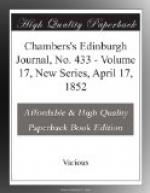The Society of Les Petites Soeurs is, it appears, a new one, having originated only a few years ago in the exertions of an old female servant, who, having saved a little money, thought it could not be better employed than in succouring the aged and infirm of her own sex. Her idea was taken up by others of her own order, as well as by women of superior grade. The society was formed, and establishments were quickly set up in various parts of France. It was only in 1851 that a detachment of the sisterhood came to England, and settled themselves in Great Windmill Street, where, whatever be their motives, it must be admitted they contribute in no slight degree to the alleviation of that vast mass of misery which seems an inseparable element of large cities. They had, at the time of our visit, forty-seven old persons under their care.
At a subsequent period of the same day, we visited an establishment somewhat similar at Hammersmith—at least similar in the repulsive character of the duties, though externally much more elegant. It is housed in a range of good buildings secluded in a garden, and is devoted to the reception of unfortunate young women who, under penitent feelings, wish to be restored to respectable society. The Sisterhood of the Good Shepherd, as they are called, entertain in this house nearly 100 such women, who, while undergoing the process of religious and moral regeneration, employ themselves in washing, so as to contribute to their own support. We saw the whole engaged in their humble employment, excepting a few who were under training in a school. At all times, in their bedrooms, at their meals, in their work-rooms, in their play-ground, they are under the immediate eye of some of the Sisters; but the general treatment includes as much kindness as is consistent with the object held in view. One trait of this kindness struck us as involving a remarkable delicacy: there is never, from first to last, one word of reference made to their former life. They are accepted as so many children coming to school for the first time. Even their names are sunk out of sight, and new ones applied. The Sisters speak of them as ‘the children.’ We learned that Protestant women are welcomed, but are expected not to stand out in inconvenient dissent from the ordinary rules of the house. We walked into the garden under the care of the mother-superior, and saw their little burial-ground, marked with low wooden crosses inscribed to Laura, to Perpetua, to Mary of the Seven Dolours, and other such names, indicating so many unfortunates who had here found a rest from their troubles. We likewise visited the chapel, the body of which is arranged for the use of the sisterhood; while a wing running off at the side of the altar, and concealed from view, is provided with seats for the penitents. The whole establishment is characterised by remarkably good taste. There is here a more cheerful tone than in the Great Windmill Street institution. The Sisters spoke, as usual, of being entirely happy—that unaccountable phenomenon to a Protestant mind.




